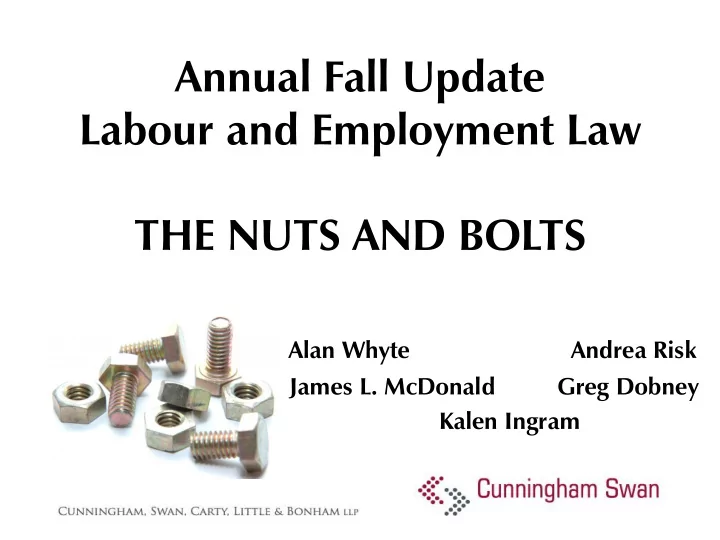

Annual Fall Update Labour and Employment Law THE NUTS AND BOLTS Alan Whyte Andrea Risk James L. McDonald Greg Dobney Kalen Ingram
Probationary Employees James L. McDonald jmcdonald@cswan.com (613) 546-8088
Probationary Employees 1) Terminating Employees on “Probation” 2) The Importance of Contract Drafting 3) Common Law Notice Periods
Terminating Probationary Employees • The purpose of probation is to provide an opportunity for the employer to assess the appropriateness of granting permanent status to an employee • It is a period to evaluate the employee’s character and abilities in the performance of the tasks for which she was hired
Terminating Probationary Employees • If not terminating without cause (with notice/pay per contract or common law), an employer must have some “justification” for the termination, although not full “just cause” • This requires a good faith determination that an employee is “unsuitable” for a given job • Unsuitability can include consideration of an employee’s character, compatibility, ability to meet performance standards and is in addition to more traditional grounds of just cause termination (e.g., theft, etc.)
Terminating Probationary Employees • In unionized workplaces, the CA will likely provide specific guidance, e.g., “not arbitrary, discriminatory or in bad faith”
Measuring “Suitability” • Establish reasonable evaluation criteria and advise the probationary employee • Provide appropriate training • Document the deficiencies and provide feedback during the probationary period, not at termination • Ultimately, probationary employees should be given a fair opportunity to demonstrate suitability to do the job they were hired for, which includes knowing of employer concerns and being given an opportunity to improve their work
Contract Drafting • Careful consideration should be given to job advertisements and their potential impact on probationary clauses • Probation periods must be reduced to writing and clearly state that the employee is on “probation” • Avoid the use of vague language • Expressly state the period of probation, including its beginning and end date • Address what notice/pay will be provided to a probationary employee in the event of termination during the probation period
Contract Drafting • Impact of the Employment Standards Act notice provisions • “…The Employee may be dismissed at any time for any reason during the probationary period, or at the end of the period, without notice or pay in lieu of notice except as required by the Employment Standards Act …” 3 month versus 6 month probation terms
Common Law Notice Periods • Courts typically award the balance of the notice period as pay in lieu of notice • That said, there is no hard and fast rule and an adjudicator will apply the same criteria used for assessing wrongful dismissal damages in the normal course, including: age, level of education and training, character of employment, inducements to leave previous secure employment, etc.
Common Law Notice Periods Cao v. SBLR LLP • 30 year old tax accountant • 3 month probationary period / no reference to ESA minimum • Worked for about 1 month before termination at height of 2008 recession • Awarded 4 months’ pay in lieu of notice
Cunningham, Swan, Carty, Little & Bonham LLP A full service law firm serving Eastern Ontario – Business Law – Wills & Estates Smith Robinson Building – Family Law 27 Princess Street, Suite 300 – Litigation Kingston, ON K7L 1A3 – Real Estate Law (613) 544-0211 – Labour & Employment Law – Municipal Law www.cswan.com – Education & Health Law – Land Use Planning, Development & Environmental Law
Recommend
More recommend